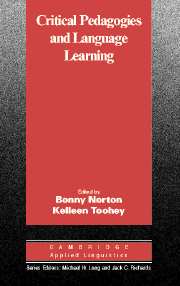Book contents
- Frontmatter
- Contents
- List of contributors
- Acknowledgments
- Chapter 1 Critical pedagogies and language learning: An introduction
- I RECONCEPTUALIZING SECOND LANGUAGE EDUCATION
- II CHALLENGING IDENTITIES
- Chapter 6 Representation, rights, and resources: Multimodal pedagogies in the language and literacy classroom
- Chapter 7 Subversive identities, pedagogical safe houses, and critical learning
- Chapter 8 “Why does this feel empowering?”: Thesis writing, concordancing, and the corporatizing university
- Chapter 9 Modals and memories: A grammar lesson on the Quebec referendum on sovereignty
- III RESEARCHING CRITICAL PRACTICES
- IV EDUCATING TEACHERS FOR CHANGE
- Author Index
- Subject Index
Chapter 6 - Representation, rights, and resources: Multimodal pedagogies in the language and literacy classroom
Published online by Cambridge University Press: 05 October 2012
- Frontmatter
- Contents
- List of contributors
- Acknowledgments
- Chapter 1 Critical pedagogies and language learning: An introduction
- I RECONCEPTUALIZING SECOND LANGUAGE EDUCATION
- II CHALLENGING IDENTITIES
- Chapter 6 Representation, rights, and resources: Multimodal pedagogies in the language and literacy classroom
- Chapter 7 Subversive identities, pedagogical safe houses, and critical learning
- Chapter 8 “Why does this feel empowering?”: Thesis writing, concordancing, and the corporatizing university
- Chapter 9 Modals and memories: A grammar lesson on the Quebec referendum on sovereignty
- III RESEARCHING CRITICAL PRACTICES
- IV EDUCATING TEACHERS FOR CHANGE
- Author Index
- Subject Index
Summary
Introduction
In this chapter, I explore the relations between modes of communication, communicative contexts, and practices in the language and literacy classroom. Through a focus on multimodality, multiple modes of communication such as language in its spoken and written forms, the visual, the gestural, and the performative, I discuss the insights that classroombased research with diverse English as a second language (ESL) learners in Johannesburg offer in relation to thinking about representation: how sociocultural worlds and local knowledge come to be constituted in classroom spaces, the tensions between talk and silence in relation to the unsayable and unthinkable within the context of gendered identities and dominant culture, and the pedagogical and ethical dilemmas these issues pose for the language teacher. I advocate what I call multimodal pedagogies - pedagogies that position the body at the center of pedagogic activity. This act of repositioning the body as a multimodal sign and resource for meaning in the classroom challenges the hegemony of language, particularly written language, in the ESL classroom. Multimodal pedagogies allow for the expression of a much fuller range of human emotion and experience; they acknowledge the limits of language, admit the integrity of silence, and do not presume closure. I argue from an equity perspective that such pedagogies offer students a more representative base for representation. However, how representative such pedagogies become is inseparable from the inclusion of multimodal assessment as part of mainstream assessment practices in the language and literacy classroom.
- Type
- Chapter
- Information
- Critical Pedagogies and Language Learning , pp. 95 - 115Publisher: Cambridge University PressPrint publication year: 2004
- 39
- Cited by

